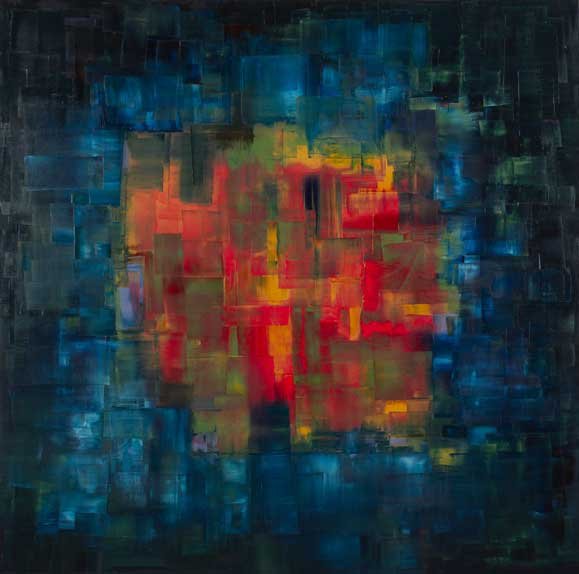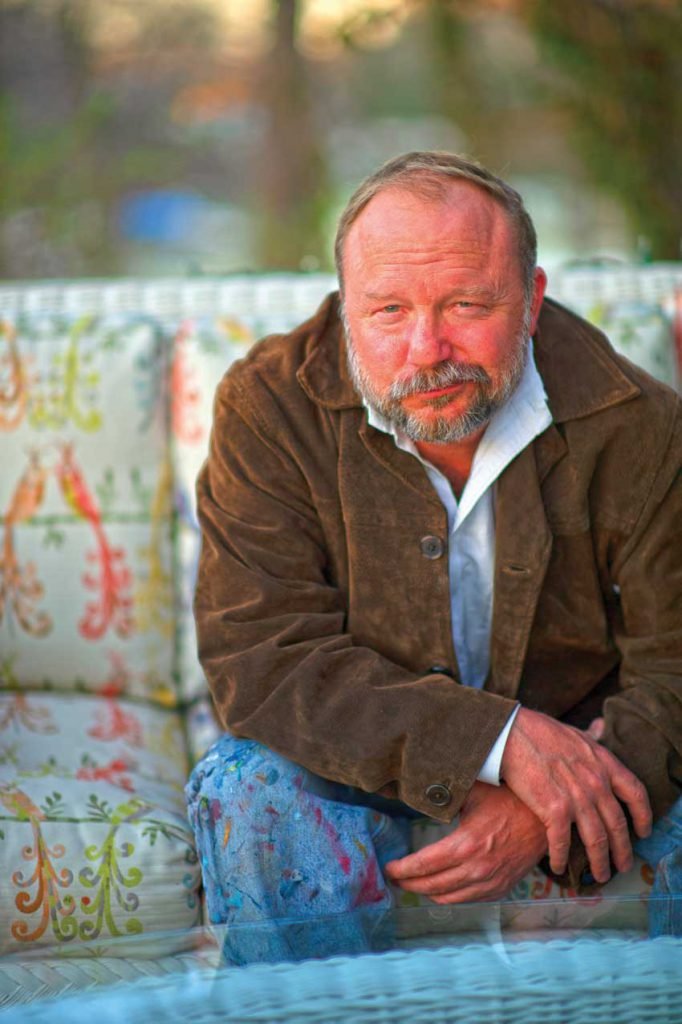+ By Brenda Wintrode
Abstractionist Jeff Nicklason holds up the dog comb he uses to drag parallel lines across a canvas. He lifts up a selection of his other tools one at a time: a trowel, a steel wire brush, a baking spatula, brushes, and a pizza cutter, but his favorite—a small squeegee from The Home Depot—he says he can no longer find. The tools are caked with the same rainbow of dried oil paint colors as the canvases stacked against his living room walls. They belong to each other.
Smears, swipes, strokes, and streaks compose a thought, a feeling, a story on a canvas, or sometimes a green board, depending on what his budget allows. The tactile and physical exercise of Nicklason’s painting process has replaced his first love: developing his own photographs, a craft he learned at age 14. When high-quality photography materials became more expensive and harder to find, and the alternative, digital photography, didn’t give him that tactile experience he sought, he changed mediums.
Now, he manipulates oils of magenta, yellow, and turquoise to manifest contrast, depth, light, and focus. One piece shows a black-blue night sky illuminated by city lights and skyscrapers spilling into a body of water. The edges, sides, and tines of his tools reinforce structure and texture, adding another dimension to the contrast in color choices. “I don’t go into any painting with a preconceived notion of what it’s going to look like. The painting evolves,” says Nicklason.
He often experiences a fugue-like therapeutic escape while creating. “It’s like yoga mixed with meditation, mixed with running at the same time, you know? The flow doesn’t come all the time, but when it comes, it’s like magic.” Nicklason’s choice of palette can range from soft and muted to bold and bursting, yet appears cohesive and harmonious within a single composition. “He’s fearless in the way he attacks a canvas,” says his girlfriend, Susan Moynihan. The self-taught Nicklason encourages friends who ask him for painting and photography lessons to just start in. “If you’re worried about screwing up, then you’re already done,” he says.
Although the Annapolis High School graduate has lived in Taos, New Mexico; Yonkers, New York; and Norfolk, Virginia; Annapolis feels like home to him. While studying political science at The George Washington University in the late 1980s and for some years after, Nicklason sang in a high-energy progressive rock band called Culture Shock and sometimes played rhythm guitar, although not as well as he would have liked. “It was one hell of a lot of fun,” he says, recalling the good times, touring from Virginia to New York and playing locally in College Park and Baltimore clubs and at D.C.’s historic nightclub, The Bayou.
He sells boats to pay his bills and says his four-years-young relationship with painting keeps him sane. He answers what he describes as an urge to paint, completing some paintings in hours, like the piece of mostly negative space with patches of blue, green, and orange, accented with thin pizza-cutter lines of black. Other pieces remain on hold or receive touch-ups over months or years.
Local businesses display his work for sale. Sheehy Infinity of Annapolis showscases seven of Nicklason’s large pieces. Thick red, yellow, and fiery-orange troweled rectangles warm the dealership’s entrance. Elaine Ebensen, president of Custom Stitch Designs for Windows, Inc., displays many Nicklason pieces in her location in the Design District, but her favorite hangs in her office. Jewel tones, pastels, warm yellows, pinks, and greens weave and swirl inside the borders of the rectangular canvas’s boundary, yet there is balance, always balance. “You always want to sort it out,” says Ebensen.
Nicklason quite possibly sorts out a range of intense emotions on his canvases. The 51-year-old reports a recent episode of depression. Both he and Moynihan began noticing in him an increased irritability, fear-based thoughts, and frequent insomnia, which pressed him to seek out a talk therapist and eventually medication. “He is self-aware enough to know something wasn’t right,” says Moynihan. Nicklason wants to talk about his experience in hopes it will benefit others. He says the episode strengthened his relationship with Moynihan. “One of the things I respect about him so much is that he’s learning from it and dealing with it. He’s a survivor, for sure,” she says.

Divorced in 2014, Nicklason, who is the father of three teenagers, settled into his current Annapolis home last spring. He calls the creative incubator atop a steep hill lined with gravity-defying deciduous trees “the tree house.” The deck protrudes from the back of the house as though suspended in air. When it’s nice out, he paints there, and on this blustery, bright March day, he says he looks forward to setting the thick cushions onto his vintage wicker deck furniture. He has filled the nonpainting space of his living room with mid-century furniture and a few lamps from Annapolis consignment stores. Two Fender amplifiers sit on the floor next to his Fender guitar, which he sometimes plays.
“After the divorce, it was a tough time. But one day I woke up and I said, ‘I’m going to be happy.’ You know, it sounds like such a bad cliché, but it was amazing, just making a declaration of happy,” says Nicklason. His salubrious efforts hang on the walls, physical creations of invisible emotions. Some already painted canvases, he admits, still need work, like the multi-layered, rust-red piece above his couch. He’s been working on it on and off for two and a half years, and it feels to him as though it’s still unfinished. █








